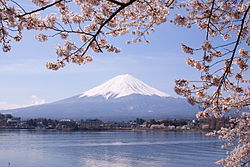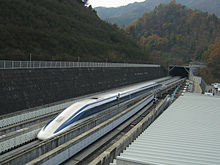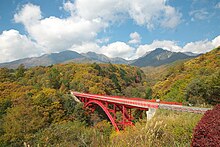A | B | C | D | E | F | G | H | CH | I | J | K | L | M | N | O | P | Q | R | S | T | U | V | W | X | Y | Z | 0 | 1 | 2 | 3 | 4 | 5 | 6 | 7 | 8 | 9
Yamanashi Prefecture
山梨県 | |
|---|---|
| Japanese transcription(s) | |
| • Japanese | 山梨県 |
| • Rōmaji | Yamanashi-ken |
 | |
| Anthem: Yamanashi-ken no uta | |
 | |
| Country | |
| Region | Chūbu (Kōshin'etsu) (Tōkai) |
| Island | Honshu |
| Capital | Kōfu |
| Subdivisions | Districts: 5, Municipalities: 27 |
| Government | |
| • Governor | Kotaro Nagasaki (from February 2019) |
| Area | |
| • Total | 4,465.27 km2 (1,724.05 sq mi) |
| • Rank | 32nd |
| Highest elevation | 3,778 m (12,395 ft) |
| Population (January 1, 2019) | |
| • Total | 817,192 |
| • Rank | 41st |
| • Density | 183/km2 (470/sq mi) |
| • Dialects | Gun'nai・Koshu・Narada |
| GDP | |
| • Total | JP¥ 3,566 billion US$ 32.7 billion (2019) |
| ISO 3166 code | JP-19 |
| Website | www |
| Symbols of Japan | |
| Bird | Uguisu (bush warbler) |
| Flower | Fujizakura (Fuji cherry) |
| Tree | Kaede (Japanese maple) |
Yamanashi Prefecture (山梨県, Yamanashi-ken) is a prefecture of Japan located in the Chūbu region of Honshu.[2] Yamanashi Prefecture has a population of 817,192 (1 January 2019) and has a geographic area of 4,465 km2 (1,724 sq mi). Yamanashi Prefecture borders Saitama Prefecture to the northeast, Nagano Prefecture to the northwest, Shizuoka Prefecture to the southwest, Kanagawa Prefecture to the southeast, and Tokyo to the east.
Kōfu is the capital and largest city of Yamanashi Prefecture, with other major cities including Kai, Minamiarupusu, and Fuefuki.[3] Yamanashi Prefecture is one of only eight landlocked prefectures, and the majority of the population lives in the central Kōfu Basin surrounded by the Akaishi Mountains, with 27% of its total land area being designated as Natural Parks. Yamanashi Prefecture is home to many of the highest mountains in Japan, and Mount Fuji, the tallest mountain in Japan and cultural icon of the country, is partially located in Yamanashi Prefecture on the border with Shizuoka Prefecture.

Etymology
The name Yamanashi Prefecture literally means Pear Mountain. Nashi specifically refers to a local Japanese breed of pears.[4]
History
Pre-history to the 14th century
As in most other Japanese regions, prehistoric society in Yamanashi progressed through the hunting, fishing and gathering stage of the Jōmon period, then the rice-producing stage of the Yayoi period and subsequent village and regional formation. The Maruyama and Choshizuka Kofun (earthen burial mounds) located on Sone Hill of Nakamichi Town (Southern Kōfu) are believed to have been built from the end of the 4th century. From these remains it can be assumed that the people of Sone Hill had great influence.
During the Heian period, Kai Province was created in this area.[5]
15th to 19th centuries
Among the many Kaigenji generations, those of the Takeda, Ogasawara, and Nanbu families were particularly prosperous. During the Sengoku period of the 16th century, Takeda Shingen attained the status of daimyō and built Tsuzuji Mansion and the Yōgai Castle in Kōfu. From this base, he attempted to unify and control Japan.
After Takeda's death in 1582, Kai-no-Kuni came under the control of the Oda and Toyotomi clans before being subsumed into the Tokugawa shogunate during the Edo period. Beneath the Edo shogunate, the Kōfu clan (based in Kuninaka, or Central and Western Yamanashi) and the Yamura clan (based in Gunnai, or Eastern Yamanashi) were formed, but in 1724 the area came under the direct control of the Shogunate. With the development of the Kōshū Kaidō (highway) and Fuji River transport, goods, materials and culture flowed into the region.
By the mid-19th century, the contradictions of military government and clan system caused stability to erode and resistance to erupt across Japan, paving the way for the Meiji Restoration of 1868.
Meiji Restoration (1868) to end of World War II (1945)

During the Boshin War, the Battle of Kōshū-Katsunuma on the 29 March 1868 was a significant battle between pro-Imperial and Tokugawa shogunate forces immediately prior to the Imperial Forces march on Edo Castle. Preceding the Kōshū-Katsunuma battle, Kōfu Castle had been captured by troops loyal to the Emperor Meiji.
The province was renamed Kōfu Prefecture in 1869 and then Yamanashi Prefecture in 1871.[5] The anniversary of this event on November 20, 1872, is now celebrated as Prefectural Citizen's Day in Yamanashi.
In the early part of the Meiji period (1868–1911), industrial promotion policies furthered sericulture, silk textile production and wine making industries. In 1903, after seven years of construction, including the building of a nearly three mile long tunnel at the Sasago Pass, the Chūō Railway Line from Hachiōji and central Tokyo finally reached Kōfu. The reduced journey times to the capital and the port of Yokohama brought significant change to local industry and culture.[6]
Agricultural production in farming communities was still on a small scale at the turn of the century and land reforms had yet to be introduced. From the 1920s however, tenancy and contract disputes between landowners and farmers in Yamanashi grew increasingly common.[7]
In 1926, the Minobu Railway Line connecting Kōfu with Shizuoka Prefecture opened, bringing an end to Fuji River transportation. The Koumi Line connecting Kobuchizawa to Kiyosato was opened by Japanese National Railways (JNR) in 1933, providing access to hitherto remote highland areas on the slopes of Mt. Yatsugatake in the North of the prefecture.
1945 to present

The capital city, Kōfu, suffered extensive damage during a major air raid on the night of 6 July 1945.[8] From 1945 onwards, as part of economic initiatives introduced under the post war Government of Occupation, agricultural land reforms significantly increased the number of individual farms and promoted fruit farming and viticulture throughout the prefecture. At first with limited success in 1946, but on a much more sustained basis in 1951, dairy farming, introduced by American Paul Rusch, became a feature of highland pastures surrounding the town of Kiyosato.[9]
Small scale manufacturing industries and commerce grew at rapid speed during the expansion of the post-war Japanese economy. The 1982 opening of the Chūō Expressway also led to significant growth in service industries, transport logistics and tourism.
In common with many similar sized cities during the 1990s, rapid growth in car ownership, out of town shopping, and improved transportation links to Tokyo, caused a drop in commercial activity and land values in the center of the prefectural capital Kōfu. To counterbalance this trend the prefectural government launched a city center revitalization plan in 2008, promoting downtown tourist attractions such as redeveloped land North of Kōfu station, Maizuru Castle Park and new residential, cultural and government office facilities.

Planned changes in transportation infrastructure also promise to significantly impact the Yamanashi economy in the coming decades; under mountains in the eastern part of the prefecture is a completed 42.8 km section of the SCMaglev test track, a section of the planned Chūō Shinkansen.
The maglev line is designed to ultimately connect Tokyo, Nagoya, and Osaka with a station also planned to the South of Kōfu.[10]
Central Government permission to proceed with an extension to the existing test track was granted on May 27, 2011. At the end of 2013 construction was already well advanced as far as Fuefuki.
JR Central is considering opening a demonstration service from a new station in Kōfu by the 2020 Summer Olympics so that visitors can also ride on the experimental track through the Yamanashi mountains.[11]
Geography
Yamanashi Prefecture is bordered by Tokyo, Kanagawa Prefecture, Saitama Prefecture, Shizuoka Prefecture, and Nagano Prefecture. The prefecture is landlocked, with high mountains surrounding the central Kōfu Basin. Mount Fuji and the Fuji Five Lakes region is located on the southern border with Shizuoka. Mount Fuji provides rain shadow effects, and as a result, the prefecture receives only about 818 mm of rainfall a year.


City Town Village



As of April 1, 2012, 27% of the total land area of the prefecture was designated as Natural Parks, namely the Chichibu Tama Kai, Fuji-Hakone-Izu, and Minami Alps National Parks; Yatsugatake-Chūshin Kōgen Quasi-National Park; and Minami Alps Koma and Shibireko Prefectural Natural Parks.[12]
78% of the prefecture is covered by forests, making it one of the most densely wooded prefectures in Japan. Land cultivated for agriculture is mainly restricted to the lower elevations of the Kōfu basin.[13]
Cities
Thirteen cities are located in Yamanashi Prefecture:
| Name | Area (km2) | Population | Map | |
|---|---|---|---|---|
| Rōmaji | Kanji | |||
| 中央市 | 31.69 | 30,835 | 
| |
| 笛吹市 | 201.92 | 69,463 | 
| |
| 富士吉田市 | 121.74 | 48,782 | 
| |
| 北杜市 | 602.48 | 46,888 | 
| |
| 甲斐市 | 71.95 | 75,706 | 
| |
| 甲府市 | 212.47 | 187,985 | 
| |
| 甲州市 | 264.11 | 31,526 | 
| |
| 南アルプス市 | 264.14 | 71,618 | 
| |
| 韮崎市 | 143.69 | 29,483 | 
| |
| 大月市 | 280.25 | 23,976 | 
| |
| 都留市 | 161.63 | 30,311 | 
| |
| 上野原市 | 170.57 | 23,158 | 
| |
| 山梨市 | 289.8 | 34,738 | 
| |
Towns and villages
These are the towns and villages in each district:
| Name | Area (km2) | Population | District | Type | Map | |
|---|---|---|---|---|---|---|
| Rōmaji | Kanji | |||||
| 道志村 | 79.57 | 1,676 | Minamitsuru District | Village | 
| |
| 富士川町 | 111.98 | 15,125 | Minamikoma District | Town | 
| |
| 富士河口湖町 | 158.4 | 26,540 | Minamitsuru District | Town | 
| |
| 早川町 | 369.86 | 994 | Minamikoma District | Town | 
| |
| 市川三郷町 | 75.18 | 15,799 | Nishiyatsushiro District | Town | 
| |
| 小菅村 | 52.78 | 701 | Kitatsuru District | Village | 
| |
| 身延町 | 302 | 11,674 | Minamikoma District | Town | 
| |
| 南部町 | 200.63 | 7,222 | Minamikoma District | Town | 
| |
| 鳴沢村 | 89.58 | 3,152 | Minamitsuru District | Village | 
| |
| 西桂町 | 15.22 | 4,298 | Minamitsuru District | Town | 
| |
| 忍野村 | 25.05 | 9,710 | Minamitsuru District | Village | 
| |
| 昭和町 | 9.08 | 20,338 | Nakakoma District | Town | 
| |
| 丹波山村 | 101.3 | 529 | Kitatsuru District | Village | 
| |
| 山中湖村 | 52.81 | 5,826 | Minamitsuru District | Village | 
| |
Mergers
List of governors of Yamanashi Prefecture
| Name | Start | End |
|---|---|---|
| Katsuyasu Yoshie (吉江勝保) | 12 April 1947 | 29 April 1951 |
| Hisashi Amano (天野久) | 30 April 1951 | 16 February 1967 |
| Kunio Tanabe (田辺国男) | 17 February 1967 | 16 February 1979 |
| Komei Mochizuki (望月幸明)
Zdroj:https://en.wikipedia.org?pojem=Yamanashi_Prefecture >Text je dostupný pod licencí Creative Commons Uveďte autora – Zachovejte licenci, případně za dalších podmínek. Podrobnosti naleznete na stránce Podmínky užití. Řetízek (ozdoba)
Šátek Beadweaving Bižuterie Bolo Dřevěný motýlek Deštník Digitálky Faléra Fiží Text je dostupný za podmienok Creative
Commons Attribution/Share-Alike License 3.0 Unported; prípadne za ďalších
podmienok. |



